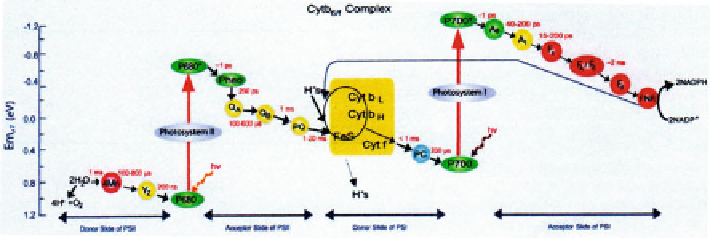Biology Reference
In-Depth Information
Fig. 16.1 The Z-scheme of oxygenic photosynthesis for electron transfer from water to oxidized
nicotinamide adenine dinucleotide phosphate (NADP). The symbols are: Mn Mn cluster,
Y Tyrosine-161 on the D1 protein, p680 a pair of Chls the reaction center (RC) Chls of PSII having
one of its absorption bands at 689 nm, P680* excited P680, Pheo the primary electron acceptor of
PS II, Q
A
the primary plastoquinone electron acceptor of PS II, Q
B
secondary plastoquinone
electron acceptor of PS II, PQ plastoquinone pool, FeS Rieske iron sulfur protein, Cyt f cytochrome
f
, CytbII high potential cytochrome
b
6, PC plastocyanin, P700 a pair of Chl
a
and
a
0
the RC Chls of
PS I, P700* excited P700, A
0
primary electron acceptor of PS I a Chl monomer, A
1
secondary
electron acceptor of PS I vitamin K, F
x
F
A
and F
B
three different iron sulfur centers, Fd ferredoxin,
and FNR ferredoxinNADP reductase. Approximate estimated times
various are also noted on
the figure. A
circular path
in the Cyt b6
f
complex symbolizes the existence of a cyclic flow around
PS I under certain conditions (Reproduced from Govindjee (
2004
); colored version is from Satoh
et al. (
2005
))
¼
the PSI reaction center. There the light energy generates a weak oxidant P700*
which receives electrons from the plastoquinone pools via cytochrome f and
plastocyanin. It also generates a strong reductant A
0
that donates electrons to
NADP
+
via a series of electron carriers. As a consequence, NADP
+
is converted
it to NADPH. The photochemical acts of PSII and PSI, and the flow of electrons
between PSII and PSI are depicted in Fig.
16.1
.
During electron and proton flow, energy rich ATP and NADPH are formed. The
energy of NAPDH and ATP is used for the enzymatic conversion of CO
2
into
carbohydrates. The latter are in turn converted into a variety of organic molecules.
In summary the efficiency of food formation by green plants depends to a great
extent on the efficiency of NADPH and ATP formation, and that in turn depends on
the efficiency of the PETS.
The rest of this chapter will therefore be devoted to a discussion of the efficiency of
the PETS and possible alterations in the circuitry of the chloroplast that may lead to a
higher efficiency of the PETS and higher plant productivity under field conditions.
16.2.2 Theoretical Maximal Energy Conversion Efficiency
of the PETS of Green Plants
This discussion is essentially extracted from a 1975 RANN report (Lien and San
Pietro
1975
).

Search WWH ::

Custom Search